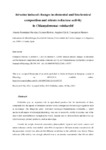Mostrar o rexistro simple do ítem
Atrazine induced changes in elemental and biochemical composition and nitrate reductase activity in Chlamydomonas reinhardtii
| dc.contributor.author | Fernández-Naveira, Ánxela | |
| dc.contributor.author | Rioboo, Carmen | |
| dc.contributor.author | Cid, Ángeles | |
| dc.contributor.author | Herrero, Concepción | |
| dc.date.accessioned | 2016-09-06 | |
| dc.date.issued | 2016 | |
| dc.identifier.citation | Fernández-Naveira A, Rioboo C, Cid A & Herrero C. (2016) Atrazine induced changes in elemental and biochemical composition and nitrate reductase activity in Chlamydomonas reinhardtii. European Journal of Phycology, 51:338–345. doi: 10.1080/09670262.2016.1163737 | es_ES |
| dc.identifier.issn | 1469-4433 | |
| dc.identifier.uri | http://hdl.handle.net/2183/17260 | |
| dc.description.abstract | Herbicides play an important role in agricultural practices but the introduction of these compounds into the aquatic environment can have severe consequences for non-target organisms such as microalgae. The ubiquitous green freshwater microalga Chlamydomonas reinhardtii, a model species in all aspects of microalgal physiology, was used to assess the toxicity of atrazine, one of the most widely used herbicides throughout the world. Atrazine acts on photosynthesis and therefore can affect non-target primary producers, such as microalgae. Growth, dry weight, elemental composition, photosynthetic pigments and protein contents and nitrate reductase activity were studied. After 96 h of exposure to different atrazine concentrations all the parameters studied were affected, but different sensitivities to the herbicide were shown. Nitrate reductase (NR) activity was strongly affected even at an atrazine concentration that did not affect growth (0.1 μM); the lowest concentrations of atrazine assayed (0.1 and 0.25 μM) provoked a > 40% decrease in NR activity and NR decreased > 80% with atrazine concentrations of 0.5 μM. C/N ratio was also affected by all the atrazine concentrations assayed. Nitrate reductase activity and C/N ratio were better indicators of the cellular stress state than data on other biochemical components or growth rate. Among cell parameters assayed, the NR activity stood out as a sensitive cytotoxicity endpoint and the activity of this enzyme can be suggested as a sensitive biomarker of stress induced by atrazine in C. reinhardtii. | es_ES |
| dc.description.sponsorship | Ministerio de Economia y Competitividad; CGL2010-15993/BOS | es_ES |
| dc.language.iso | eng | es_ES |
| dc.publisher | Taylor & Francis | es_ES |
| dc.relation.uri | http://dx.doi.org/10.1080/09670262.2016.1163737 | es_ES |
| dc.rights | This is an Accepted Manuscript of an article published by Taylor & Francis in European Journal of Phycology on 06/05/2016, available online: http://www.tandfonline.com/10.1080/09670262.2016.1163737 | es_ES |
| dc.subject | Atrazine | es_ES |
| dc.subject | Chlamydomonas reinhardtii | es_ES |
| dc.subject | Nitrate reductase | es_ES |
| dc.subject | Toxicity | es_ES |
| dc.title | Atrazine induced changes in elemental and biochemical composition and nitrate reductase activity in Chlamydomonas reinhardtii | es_ES |
| dc.type | info:eu-repo/semantics/article | es_ES |
| dc.rights.access | info:eu-repo/semantics/embargoedAccess | es_ES |
| dc.date.embargoEndDate | 2017-03-03 | es_ES |
| dc.date.embargoLift | 2017-03-03 | |
| UDC.journalTitle | Journal of Phycology | es_ES |
| UDC.volume | 51 | es_ES |
| UDC.issue | 3 | es_ES |
| UDC.startPage | 338 | es_ES |
| UDC.endPage | 345 | es_ES |






